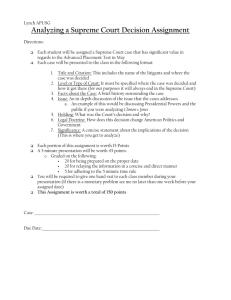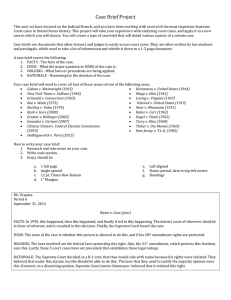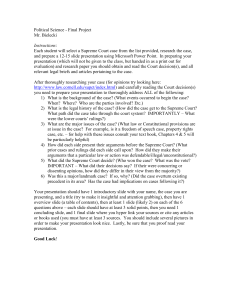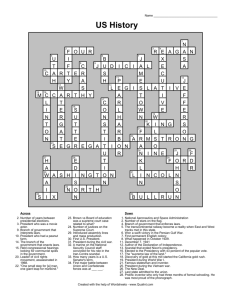The Case Salience Index (CSI)
advertisement
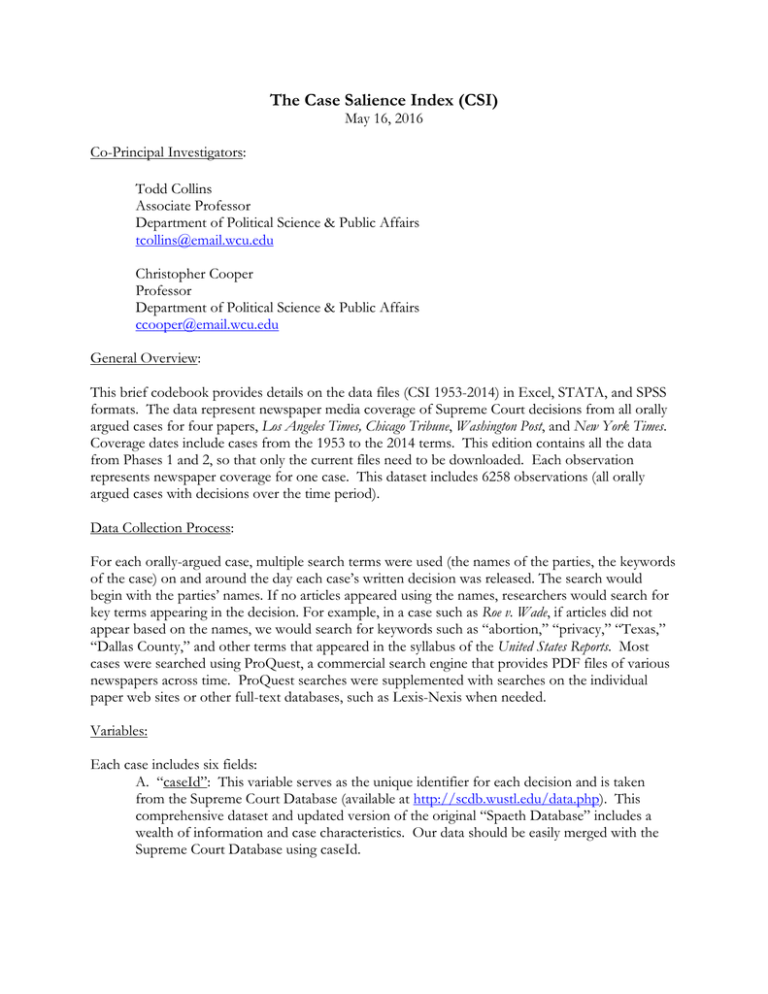
The Case Salience Index (CSI) May 16, 2016 Co-Principal Investigators: Todd Collins Associate Professor Department of Political Science & Public Affairs tcollins@email.wcu.edu Christopher Cooper Professor Department of Political Science & Public Affairs ccooper@email.wcu.edu General Overview: This brief codebook provides details on the data files (CSI 1953-2014) in Excel, STATA, and SPSS formats. The data represent newspaper media coverage of Supreme Court decisions from all orally argued cases for four papers, Los Angeles Times, Chicago Tribune, Washington Post, and New York Times. Coverage dates include cases from the 1953 to the 2014 terms. This edition contains all the data from Phases 1 and 2, so that only the current files need to be downloaded. Each observation represents newspaper coverage for one case. This dataset includes 6258 observations (all orally argued cases with decisions over the time period). Data Collection Process: For each orally-argued case, multiple search terms were used (the names of the parties, the keywords of the case) on and around the day each case’s written decision was released. The search would begin with the parties’ names. If no articles appeared using the names, researchers would search for key terms appearing in the decision. For example, in a case such as Roe v. Wade, if articles did not appear based on the names, we would search for keywords such as “abortion,” “privacy,” “Texas,” “Dallas County,” and other terms that appeared in the syllabus of the United States Reports. Most cases were searched using ProQuest, a commercial search engine that provides PDF files of various newspapers across time. ProQuest searches were supplemented with searches on the individual paper web sites or other full-text databases, such as Lexis-Nexis when needed. Variables: Each case includes six fields: A. “caseId”: This variable serves as the unique identifier for each decision and is taken from the Supreme Court Database (available at http://scdb.wustl.edu/data.php). This comprehensive dataset and updated version of the original “Spaeth Database” includes a wealth of information and case characteristics. Our data should be easily merged with the Supreme Court Database using caseId. B. “CSI”: This is the Case Salience Index. It is the addition of all four of our paper scores and ranges from zero to eight. A value of zero (0) indicates that the decision is not reported anywhere in any of our four papers. A value of eight (8) indicates that the decision was covered on the front page of all four of the four papers. Values in between indicate various combinations of coverage. C. Individual Paper Scores (“laScore,” “chScore,” “washScore,” “nyScore”) : These variables indicate individual paper coverage of the decision in each of our four newspapers (the Los Angeles Times, Chicago Tribune, Washington Post, and New York Times, respectively): Zero (0): Indicates no coverage anywhere in the paper One (1): Indicates that the decision was covered somewhere in the paper, but not on the front page. Two (2): Indicates that the decision was covered on the front page of the paper. Other Formatting or Problems: If other problems arise with the files or further information is needed, please do not hesitate to contact us. Data Usage Examples: For past examples of usage (and further explanation of the data), please refer to prior published articles from the principle investigators, including: Collins, Todd A. and Chris Cooper. 2016. "The Case Salience Index, Public Opinion, and Supreme Court Decision Making.” Justice System Journal [forthcoming and available on line] Collins, Todd A. and Chris Cooper. 2015. "Making the Cases "Real": Newspaper Coverage of U.S. Supreme Court Cases 1953-2004." Political Communication 32:23-42 Collins, Todd A., and Chris A. Cooper. 2012. “Case Salience and Media Coverage of Supreme Court Decisions: Toward a New Measure” Political Research Quarterly 65:396-407 Acknowledgements: We gratefully acknowledge the assistance of several entities at Western Carolina University, including the Hunter Library, the Graduate School, the Public Policy Institute, and the Department of Political Science and Public Affairs. Without the commitment from all of these groups, we would not have been able to complete this project. We also are indebted to the several graduate students that assisted with the data collection process.


